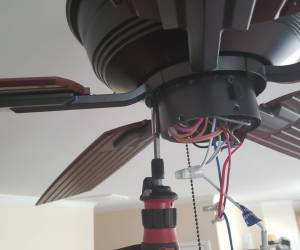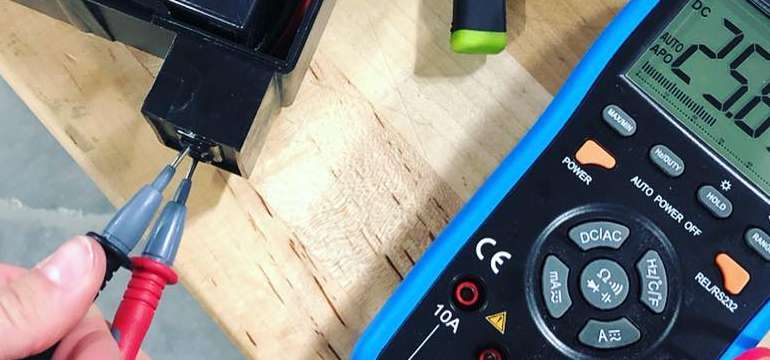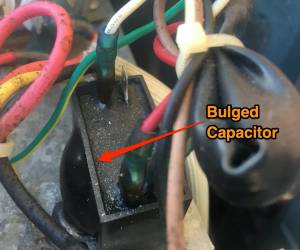It is the middle of a hot summer day, and the heat is killing you. Unfortunately, that ceiling fan you installed last year has decided to up and call it quits. It should be pushing cool air around the room, creating a comfortable breeze that keeps you cool. Instead, your ceiling fan stopped working, but the light still works. You know that something simple must be wrong, but you just can’t figure out what it is.
If you need to get your ceiling fan spinning again in a hurry, here are the steps you need to take to pinpoint the problem.
Check the Wiring
 The first thing you need to do is to make sure that power is actually reaching your fan. If you have a light fixture attached to the fan and the ceiling fan doesn’t work, but the light does, then you know that the power supply is sufficient. This means that you will likely have to do a bit more detective work to uncover the culprit of your stagnant ceiling fan.
The first thing you need to do is to make sure that power is actually reaching your fan. If you have a light fixture attached to the fan and the ceiling fan doesn’t work, but the light does, then you know that the power supply is sufficient. This means that you will likely have to do a bit more detective work to uncover the culprit of your stagnant ceiling fan.
From here, you should check the wiring. Because the fan is constantly in motion, it is very probable that you simply have a loose connection.
In order to check the wires, turn off the power that goes to the ceiling fan at the source. Then, you have to evaluate how to get into the motor housing. Some models have a hanging device where you can leave them hang from a mounting bracket while you look inside. If not, then you will need a second person to hold the fan for you while you work.
Do a simple visual check for wires that are short, disconnected, or loose. It might be a relatively simple fix, and you can rehang the fan right away. Otherwise, you might be looking at more extensive issues.
Test the Connections

While you have the wiring open, you need to use a voltmeter to test the actual connections. Start with the fan motor itself. If the voltmeter shows that you are getting current to the motor, but nothing is happening, then it is a sign that your motor is completely dead.
You will have to replace it or repair it in its entirety to get your fan back up and running again. It may be more economical to simply replace the ceiling fan if this is the case.
Humming Sounds
If your ceiling fan quit working, but the light still works, and you hear a humming sound, you might be looking at a blown motor capacitor. They can burn out for a number of reasons, the major two reasons being old age or overheating. Checking this part of the fan is also relatively simple.
 Just as you did before, disconnect all power to the ceiling fan in order to protect yourself from harm. Next, you need to remove the motor housing and look for the capacitor. Generally, it should be a small black box connected to the pull cord. Even an amateur should be able to tell whether this piece is burnt out. The damage is often extremely visible or the box is melted from overheating.
Just as you did before, disconnect all power to the ceiling fan in order to protect yourself from harm. Next, you need to remove the motor housing and look for the capacitor. Generally, it should be a small black box connected to the pull cord. Even an amateur should be able to tell whether this piece is burnt out. The damage is often extremely visible or the box is melted from overheating.
You can replace them relatively easily, but you must make sure to get the same capacitance ratings as before. Without the same electrical requirements, it will not be able to turn the fan back on.
Blades Won’t Spin
Check to see if the blades are able to spin at all by manually trying to manipulate them. If you find that the blades are unable to spin, then the bearings in the motor are likely frozen. The bearings could be replaced, but it is a rather costly repair. Many people find that it is actually cheaper for them to purchase a brand new fan instead of investing in the repair.
Motor Running but Blades Won’t Work
If you can tell that your motor is running, but the blades won’t turn, the issue may be a broken flywheel. This is not a particularly common problem, but you may find that it has broken over the years. It can be very easy to replace a flywheel, and the parts are relatively inexpensive for most fan models.
Calling the Professionals
If your ceiling fan stopped working, but the light still works, then you know there is an electrical issue of some kind with your fan. While you can definitely work on some of these simple tasks on your own at home, you may want to consider bringing in a professional. Particularly if you have never worked with electricity before, you may need an expert’s guidance. Alternatively, you may just want to install a whole new ceiling fan if it is old. Don’t hesitate to reach out for help if you need it!
- Is a Hot Water Heater In the Attic a Good or Bad Idea? - July 18, 2021
- Lawn Mower Starts Then Dies – Here’s the Fix! - June 21, 2021
- Can You Mix Pine-Sol and Bleach? - September 9, 2020
